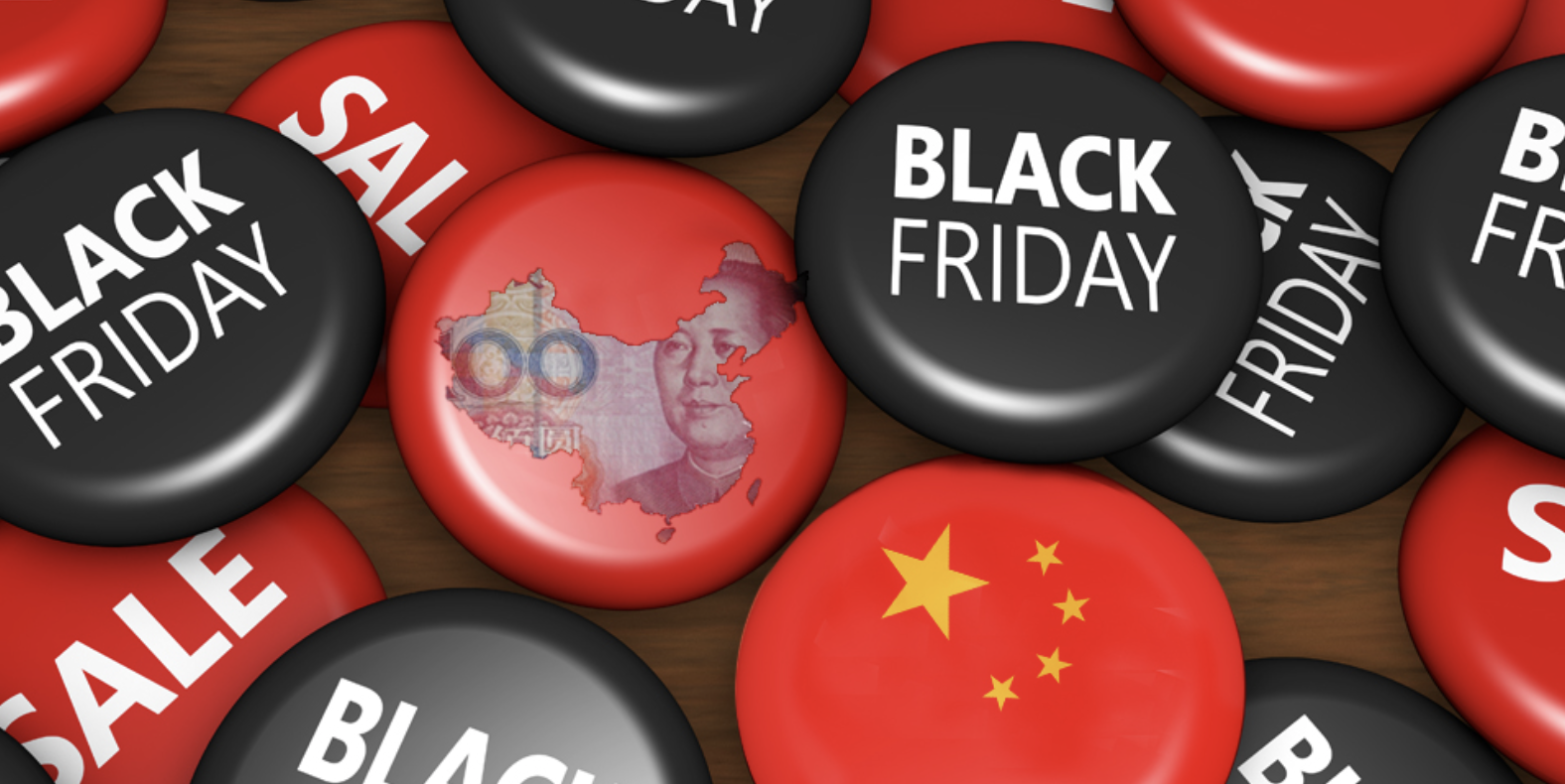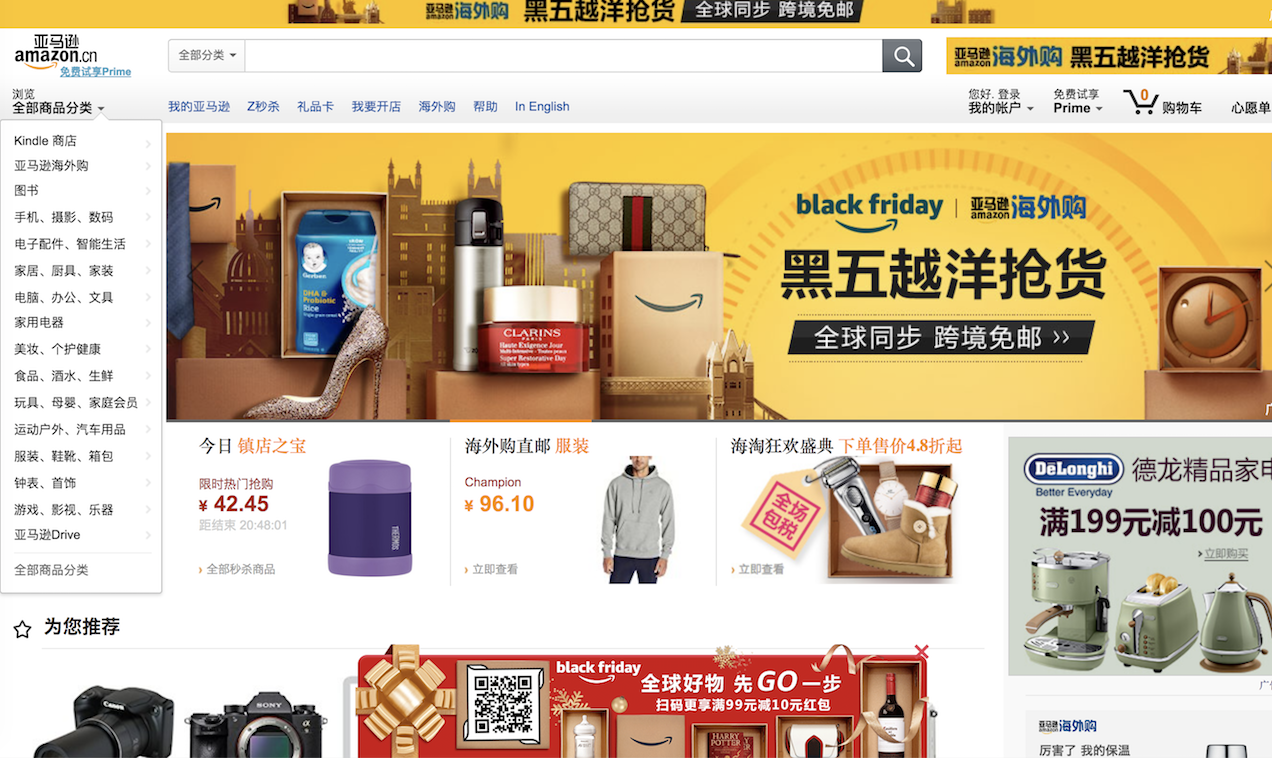Black Friday 2017: Bigger than Singles’ Day for International Retailers in China
FGRT's Black Friday reports highlight big opportunities for international retailers to launch tailored campaign for Chinese customers.
by Deborah Weinswig

2017 November 24, Fung Global Retail & Technology
This report shows why Black Friday has the potential to be a
bigger opportunity than Singles’ Day for international retailers
operating in China, shows how consumer behavior during the
event differs from that of Singles’ Day and gives several
recommendations on how international retailers can maximize
the opportunities Black Friday offers.
Last year on Black Friday, a number of international retailers in China recorded revenues 2.5 times higher than that made during Singles’ Day 2016.
International retailers face significantly less competition from domestic Chinese retailers compared to Singles’ Day, as Chinese shoppers view Black Friday mainly as an event during which they can buy overseas products at reduced prices.
To make the most of the opportunities that Black Friday offers in China, international retailers should ensure they are prepared with sufficient fulfillment capacity and inventory, and by leveraging Chinese mobile payments.
A Bigger Opportunity than Singles’ Day for International Retailers
Black Friday has become a popular shopping event for Mainland Chinese
consumers. While Singles’ Day continues to beat records year after year, for
European retailers with a presence in China, Black Friday has the potential
to be a bigger opportunity than Singles’ Day. Cross-border shoppers in
China are familiar with Black Friday in Western markets and consider it an
opportunity to buy overseas products directly from international retailers at
reduced prices.
This report shows why Black Friday has the potential to be a bigger
opportunity than Singles’ Day for international retailers operating in China,
shows how consumer behavior during the event differs from that of Singles’
Day and gives several recommendations on how international retailers can
maximize the opportunities Black Friday offers.
We report insights from Azoya—a cross-border e-commerce service provider that partners with international retailers to expand their businesses in China—on how retailers they collaborate with are approaching Black Friday.
An Occasion to Shop for Overseas Products from International Retailers
Black Friday, a shopping festival imported from the US to China—where
Singles’ Day reigns supreme—may be overlooked by some external
observers who fail to see it as a significant retail opportunity.
Black Friday begins barely a week after the end of the global Singles’ Day
shopping festival, the brainchild of Alibaba Founder Jack Ma. This year,
Singles’ Day generated a record-breaking total gross merchandise volume
(GMV) of $25.3 billion (¥168.2 billion), up 39% year over year in renminbi
terms. Total US online sales for Black Friday in 2016 of $3.0 billion pale in
comparison, as highlighted in our report Singles’ Day 2017 Wrap-Up: New
Retail Helps Boost Singles’ Day Sales to Record High.
Recently in China, however, Black Friday has become an occasion to shop
for overseas products directly from international retailers at reduced prices,
and this helps those international retailers stand out in the Chinese e-
commerce market, which is dominated by domestic heavyweights such as
Alibaba and JD.com.
Chinese consumers are keen fans of overseas products. A 2016 survey of
consumers in Mainland China by market research firm YouGov found that
20% of respondents considered being able to purchase online from
overseas brands and retailers an important feature of e-commerce .
Last year on Black Friday, a number of international retailers in China recorded sales 4–10 times higher than daily average sales in October 2016, and revenues 2.5 times higher than that made during Singles’ Day 2016, according to Azoya.
This year, sales and revenues on Black Friday in China are expected to exceed last year’s event, given figures recorded by Azoya on November 20, the first day of the promotional period:
On November 20, turnover generated by Black Friday promotional campaigns was 150% higher than Singles’ Day for many of the international companies that Azoya collaborates with in the Chinese market.
European retailers Feelunique (cn.feelunique.com) and Bodyguard Apotheke (BA Mall in China) broke their historical sales records on the first day of the Black Friday campaign.
The number of user visits (UV) Feelunique recorded at 10:00 a.m. on November 20 was four times larger compared to the same time on Single’s Day 2017 (November 11).
Less Pressure from Domestic Competitors
On Black Friday, International retailers face significantly less competition
from domestic Chinese retailers than they do on Singles’ Day, as Chinese
shoppers see Black Friday mainly as an event during which overseas
products can be bought directly from international retailers at reduced
prices.

Amazon China is expected to be a strong competitor for domestic and
international retailers during Black Friday this year. Earlier this year on July
11, Chinese shoppers experienced Amazon’s Prime Day event for the first
time ever. Following the successful event, Amazon reported—somewhat
ambiguously—that “Amazon China and overseas” sales on Prime Day grew
by almost 300% versus the same day the previous year.
Domestic retailers have also launched their own Black Friday campaigns, mainly on their cross-border e-commerce websites:
Alibaba’s Tmall runs Black Friday sales on the Tmall Global site (tmall.hk), but not on the domestic portal tmall.com.
Kaola, JD Worldwide and RED each have their own versions of Black Friday sales.
Shopping Patterns on Black Friday
Azoya observed the following shopping patterns related to Black Friday in China:
Azoya saw a 26% increase in average basket value on the first day of the Black Friday campaign (November 20, 2017) compared to Singles’ Day (November 11, 2017) for websites from over 25 international retailers the company collaborates with.
Chinese customers have a bigger appetite for “light” luxury products: one of Azoya’s retailer recorded sales of designer bags and accessories five times that of Singles’ Day.
Azoya noted that many shoppers held back on purchasing from overseas retailers during Single’s Day, instead preferring to purchase on Black Friday.
How to Maximize Black Friday Opportunities in China: Lessons from Singles’ Day and Beyond
This year Black Friday has the potential to generate substantial order volumes for international retailers operating in China. To make the most of the opportunities that this shopping event can bring, Azoya recommends overseas retailers ensure they have sufficient marketing capacity and have enough inventory on hand to fulfill all orders. They do not want to a repeat of the mistakes of Singles’ Day, which saw an influx of orders for international retailers collaborating with Azoya in Mainland China, with some taking up to a week to “digest” these orders.
Furthermore, Azoya recommends retailers leverage Chinese mobile payments to attract Mainland Chinese customers: Alipay, WeChat Pay and Union Pay are the most frequently used payment platforms.
Popular Chinese mobile payment services and social-media channels can also be leveraged at brick-and-mortar stores overseas to cater to Chinese customers on Black Friday. For example, the location-based service system from Chinese mobile app WeChat can help retailers reach out to Chinese customers by sending a short video to the user’s timeline, or WeChat Moments page (similar to Facebook’s news feeds).
Read also on Fung Global Retail & Technology. This is a collaboration work between Azoya and Fung Global Retail & Technology.
Our special appreciation goes to:
Deborah Weinswig, Managing Director, FGRT
Filippo Battaini, Research Associate, FGRT